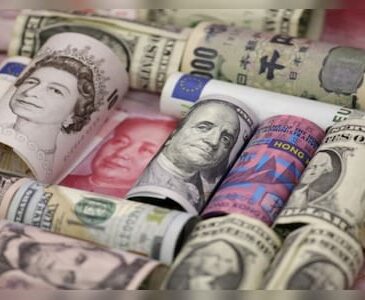bne IntelliNews – The ruble overtakes the yuan as Russia’s main currency to settle international trade deals

The ruble has overtaken the yuan to become the main currency used to settle international trade deals, the Central Bank of Russia (CBR) reported on April 8.
The share of the ruble used to settle international trade deals has rise to over 40%, up from a third last year, while the share of the yuan has slipped slightly to around 30%.
The CBR also reported that in March the share of the yuan in the on-exchange and over-the-counter FX markets reached new all-time highs of 53% and 39.6%, respectively.
Following the SWIFT sanctions that were imposed only days after Russia’s invasion of Ukraine in February, Russia has been cut off from using the dollar to settle trade deals and switched almost entirely to using the yuan for international transactions.
The change has been made easier by many of Russia’s trade partners from the so-called friendly countries being likewise unsettled by Washington’s decision to weaponize its currency and they have also been happy to settle more of their foreign trade transactions using national currencies.
The share of the ruble in Russia’s international trade has significantly increased since the start of this year. Ruble transactions with the EU rose to 49% (due to sanctions exemptions), with South America increased to 35%, and with Africa, the growth more than doubled to 48%. Meanwhile, the shares of the dollar and euro in trade with Asia and Africa fell by more than half.
Despite sanctions, Russia has seen the ruble emerge as the predominant currency in its foreign trade payments, according to the latest figures from the CBR. According to February’s data the ruble accounted for 41.6% of payments for Russian exports and 38.1% for imports, surpassing its previous records.
The ruble’s share in Russia’s foreign trade transactions accounted for less than a third of all settlements in 2023. The data also highlighted a decline in the use of the Chinese yuan, which has been a proxy for dollar until now, with its share in Russian export payments dropping to 30.2%, and in import payments to 32.3% in the first quarter of this year.
Russia has completely expunged the dollar and the euro from its gross international reserves which are hovering at just under $600bn as of March. Of that money, half is frozen in accounts in Europe, but from the remainder half ($150bn) is in monetary gold and the rest in yuan, plus a smattering of other “friendly” currencies.
The dollar continues to dominate global trade settlements, accounting for some 85% of all transactions, a share that has changed little in the last two years. However, following the freezing of the CBR’s $300bn in reserves, the share of the dollar in global reserves has been noticeably falling and current accounts for 58% of globally allocated foreign-exchange reserves as of December 2023 – a 25-year low as emerging markets begin to reduce their exposure to the dollar.
Trade relations with friendly countries flourish but problems remain
In the case of China this has been made easier as Russia and China run a relatively balanced trade regime, importing and exporting almost the same amount of goods in monetary terms. Mutual trade has been growing fast and topped the $200bn turnover goal set by Russian President Vladimir Putin and Chinese President Xi Jinping a few years ago.
China is now by far Russia’s biggest trade partner and has gone a long way to offsetting the loss of trade with the EU, formerly Russia’s biggest trade partner with a pre-war trade turnover on the order of $350bn a year. Turkey has also emerged as a major trade partner and has decided to not participate in the sanctions regime on Russia.
Russia still had a $140bn trade surplus with the EU in 2023 thanks to ongoing exports of oil, gas, fertilisers and other key inputs that the EU cannot source elsewhere as well as the various sanction exemptions won by countries like Hungary, Austria and Slovakia.
The situation with India is much more difficult as Russia runs a very large trade surplus thanks to exploding levels of oil exports to India, whereas India exports relatively little to Russia. India’s trade deficit doubled in the first nine months of 2023 to $50bn due to the soaring oil imports, the Russian ambassador to India said in December after mutual trade between the two countries more than doubled in the first half of last year.
As a result, Russia has been building up a large excess of rupees in Indian banks that it is struggling to convert into other more useful currencies given the rupee is only partially convertible and as that conversion process has to pass through a conversion to dollars before it can be converted to another currency, that route is not available to Russia.
Life has been made even more difficult for Russia since December when the Office of Foreign Assets Control (OFAC) started introducing a set of smart sanctions where it is threatening individual banks and companies that continue to deal with Russia with secondary sanctions. As a result major banks in China, Turkey and the UAE have closed accounts with Russian partners and are refusing to continue to do business with Russian entities. Two of China’s biggest banks have closed shop in Russia entirely, which were instrumental in facilitating trade payments. However, experts say that as there are thousands of banks in China, most of which don’t have any presence in the US and so immune to sanctions, the Kremlin is expected to find new workarounds to continue its business and settle trade payments.


